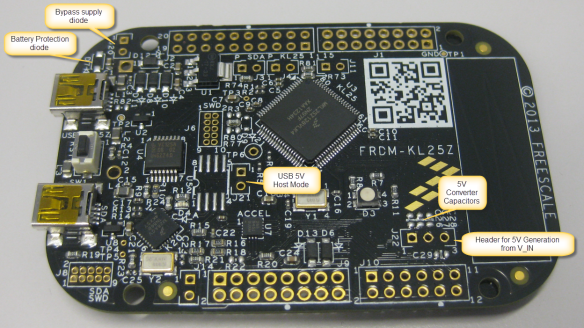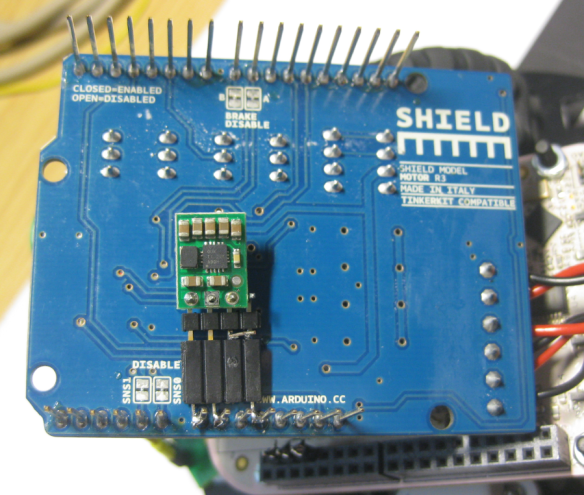About a year ago I started to use the FRDM-KL25Z board (RevD). Finally, I had it in my hands: the RevE board from Mouser 🙂 Using the RevD board, I faced several problems:
- 3.3V supply voltage drop because of low-cost diode D1 (see this post)
- Hard to use USB host mode, as no 5V supplied to the USB bus (see this post)
- No 5V generated from V_IN (see this post)
The good news: all of them have been improved 🙂 in the FRDM-KL25Z RevE Schematics:
Board Frontside
The picture below shows the most important changes:
Board Power Supply
There are changes to the board with respect of power supply. The 3.3V power supply voltage drop has been fixed with better diodes with less voltage drop. Additionally the board has header J20 to bypass the voltage drop over D12:
Nearby J20 there is as well the unpopulated D7: before this diode was part of D1 on RevD. With this diode unpopulated, using the batter connector on the backside of the board requires this footprint populated (either with diode or 0-Ohm resistor).
5V Voltage Converter
As the RevD is not able to generate 5V to the Arduino header (pin 10 on J9), this makes it difficult to use it with any Arduino shield which needs to be supplied with 5V e.g. from the battery voltage. So far I have added a 5V regulator as the Pololu (seee ‘5V Power for the Shield’ in this post). Another way is to solder a 5V (e.g. Pololu tiny S7V7F5) converter to the Ardunino shield as shown in this post):
Now the board has a 3 pin header (J22) on the board so such a converter (or a 3 pin ) can be soldered.
Additionally there is space for 3 10 uC capacitors (C26, C27, C28). Alternatively a 7805 in a TO-220 package can be used as low-cost alternative.
USB Host 5V Voltage
For USB host mode, the board needs to supply 5V to the bus. So far I had to use a wire (see this post). Now the board has a header J21 and resistor R82 option:
With J21 I can supply 5V to the bus, and with R82 I can pull down the USB ID pin.
❗ The 5V are *not* protected against over-current. So I need to make sure I do not draw too much current.
Board Backside
The backside of the board has the RevE sticker. The pads for J6 and J8 are a bit smaller now to make it easier to solder a SWD 10pin debug connector. Additionally the wrong pin name writing has been fixed:
Summary
The new RevE fixes many limitations of the RevD board, and makes it easier to be used either in USB Host mode or with Arduino shields. Until then I’ll use my patched boards, but I’ll start using the new RevE boards in my courses as soon as I run out with the RevD boards. And I will use Mouser instead of Farnell/Element14: Farnell has increased the price (why?), and Mouser is able to deliver the boards as low as CHF 12.14 (with free shipping!) compared to Farnell/Element14 where the board costs CHF 17.05. Ordering many boards for a class makes a big difference. Definitely, the RevE board is better than RevD, and less expensive than Element14 :-).
Happy Reving 🙂












Those are welcome changes. This whole power thing is an area I find lacking proper thought on many of these “demo” boards by all manufacturers.
I am in USA. I clicked on your ch.mouser.com link as they are one of my normal suppliers, and I was interested in seeing about the “free shipping”. (since S&H seems to to be the new profit model for many companies) Then I went to my normal bookmarked http://www.mouser.com and it snapped back to the ch. version. This was in Firefox. I had a hell of a time getting Firefox to forget ch. and start using www. again. Had to clear the recent history and cookies. Very odd. I’ve never seen anything like that happen before. I routinely use ebay.de, for example without this weirdness.
-Bill
LikeLike
I have a hard time with this ‘geo-locking’ of many sites. I see many times that there are higher prices in the local store site, where it is less expensive in the US, even with shipping included.
LikeLike
Pingback: 5V Generation from V_IN on the Freedom Board RevE | MCU on Eclipse
Pingback: USB MSD Host for the FRDM-K20D50M Board | MCU on Eclipse
Pingback: FRDM-KL25Z talks to Android Phone | MCU on Eclipse
Thanks for writing this post. It is by far the most straight forward reference on the FRDM-KL25Z I’ve found so far.
Question on the enabling USB Host functionality with J21 and R82: It looks like grounding the USB ID pin determines whether a device is a USB host or USB peripheral. Does the FRDM-KL25Z have the ability to switch between host and peripheral mode and would I need to bridge and remove R82 to do so? Also, does R82 need to have a certain resistance or can I just short the pads together?
LikeLike
Hi Michael,
thanks, good to hear that things are useful. I’m travelling right now so have very limited access to specs/etc. But I would suggest that you check out the schematics of the TWR-SER board (www.freescale.com/tower) which to my knowledge has a flexible way to deal with host/device/OTG.
I hope this helps.
LikeLike
Pingback: A new Freedom Board: FRDM-KL46Z | MCU on Eclipse
Pingback: Tutorial: Using the FRDM-KL25Z as Low Power Board | MCU on Eclipse